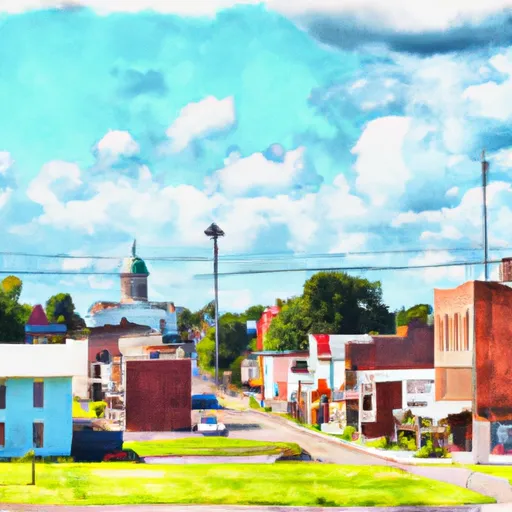-
 Snoflo Premium
Snoflo Premium
Get unlimited access to all our content
With no Ad interruptions! - Start Your Free Trial Login with existing account
Sharpsville
Eden Index
Climate
7.9
•
Recreation
2.2
•
Community
2.8
•
Safeguard
4.6/10

Sharpsville, Indiana, is a small town located in the northern part of the state. It experiences a humid continental climate with hot summers and cold winters. Average temperatures range from around 20°F (-6°C) in winter to 85°F (29°C) in summer, and precipitation is fairly evenly distributed throughout the year.
Hydrologically, Sharpsville is situated in the Upper Wabash River watershed. The local waterways, including the Wabash River and its tributaries, provide opportunities for fishing, boating, and other water-based activities. The region is known for its diverse fish species, including bass, catfish, and walleye.
Outdoor recreation enthusiasts have a range of options to enjoy in Sharpsville and its surrounding areas. The town is surrounded by picturesque countryside, offering opportunities for hiking, camping, and bird-watching. Nearby parks and nature reserves, such as the nearby Mississinewa Reservoir and Mounds State Park, provide additional recreational activities, including swimming, picnicking, and wildlife observation.
Overall, Sharpsville, Indiana, offers a pleasant climate, diverse hydrology constituents, and various outdoor recreation opportunities for residents and visitors alike.
What is the Eden Index?
The Snoflo Eden Index serves as a comprehensive rating system for regions, evaluating their desirability through a holistic assessment of climate health, outdoor recreation opportunities, and natural disaster risk, acknowledging the profound impact of these factors on livability and well-being.
Climate Health Indicator (CHI): 7.9
Sharpsville receives approximately
1074mm of rain per year,
with humidity levels near 83%
and air temperatures averaging around
11°C.
Sharpsville has a plant hardyness factor of
5, meaning
plants and agriculture in this region thrive during a short period during spring and early summer. Most
plants will die off during the colder winter months.
By considering the ideal temperature range, reliable water supplies, clean air, and stable seasonal rain or snowpacks, the Climate Health Indicator (CHI) underscores the significance of a healthy climate as the foundation for quality living.
A healthy climate is paramount for ensuring a high quality of life and livability in a region, fostering both physical well-being and environmental harmony. This can be characterized by ideal temperatures, reliable access to water supplies, clean air, and consistent seasonal rain or snowpacks.
Weather Forecast
Streamflow Conditions
Wabash
Area Rivers
Wabash
Snowpack Depths
Wabash
Reservoir Storage Capacity
Wabash
Groundwater Levels
Recreational Opportunity Index (ROI): 2.2
The Recreational Opportunity Index (ROI) recognizes the value of outdoor recreational options, such as parks, hiking trails, camping sites, and fishing spots, while acknowledging that climate plays a pivotal role in ensuring the comfort and consistency of these experiences.
Access to outdoor recreational opportunities, encompassing activities such as parks, hiking, camping, and fishing, is crucial for overall well-being, and the climate plays a pivotal role in enabling and enhancing these experiences, ensuring that individuals can engage in nature-based activities comfortably and consistently.
Camping Areas
| Campground | Campsites | Reservations | Toilets | Showers | Elevation |
|---|---|---|---|---|---|
| Starve Hollow State Rec Area | 200 | 552 ft | |||
| Clark State Forest | 45 | 851 ft | |||
| Houchins Ferry - Mammoth Cave National Park | None | 437 ft | |||
| Salt River Rec Area | None | 428 ft | |||
| Brown County State Park | 430 | 899 ft | |||
| Buffalo Trace Co Park | 64 | 803 ft | |||
| South Harrison Co Park | None | 754 ft | |||
| Delaney Creek Park | None | 584 ft | |||
| Jackson - Washington State Forest | None | 672 ft | |||
| OBannon Woods State Park | 280 | 784 ft |
Nearby Ski Areas
Catastrophe Safeguard Index (CSI):
The Catastrophe Safeguard Index (CSI) recognizes that natural disaster risk, encompassing floods, fires, hurricanes, and tornadoes, can drastically affect safety and the overall appeal of an area.
The level of natural disaster risk in a region significantly affects safety and the overall livability, with climate change amplifying these risks by potentially increasing the frequency and intensity of events like floods, fires, hurricanes, and tornadoes, thereby posing substantial challenges to community resilience and well-being.
Community Resilience Indicator (CRI): 2.8
The Community Resilience Indicator (CRI) recognizes that education, healthcare, and socioeconomics are crucial to the well-being of a region. The CRI acknowledges the profound impact of these elements on residents' overall quality of life. By evaluating educational resources, healthcare accessibility, and economic inclusivity, the index captures the essential aspects that contribute to a thriving community, fostering resident satisfaction, equity, and social cohesion.

